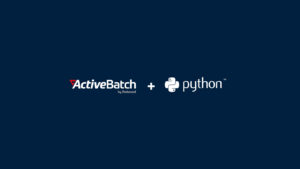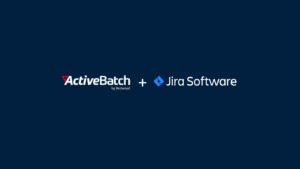How to Use Marketing Workflow Automation In Your Business
Learn how ActiveBatch can enable marketing workflow automation with its event-based workflows and seamless integration. This page covers examples and use cases for automated marketing processes and email marketing and addresses how ActiveBatch can be set up for marketing processes.

IT and DevOps teams aren’t the only teams that benefit from workflow automation platforms — Marketing teams do, too. And though the market is full of marketing automation software, did you know that workflow automation tools like ActiveBatch can actually play a critical part in marketing automation workflows? Here’s how that works, and some use cases for how it all works.
Automated email marketing
There are many types of marketing campaigns and customer experiences that can be automated. Here are just a few examples:
- Welcome emails
- Cart abandonment sequences
- Automated follow-up series of emails
- Re-engagement email campaigns
- New customer onboarding
- Lead nurture workflows and drip campaigns
- Upsell workflows and campaigns
- Social media posts
Have you noticed what nearly all these have in common? They’re related to email marketing. Email marketing automation is a huge boon for any marketing team, as it removes the manual, repetitive tasks that go into executing the email portions of a marketing strategy.
Think about the times when you visit a website, browse the offerings, put something in your cart, and then don’t make a purchase. Are you surprised when you receive an email reminding you that you haven’t checked out yet? That’s an event-based, automated workflow that sends abandoned cart emails. Such emails boost your conversion rates by spurring purchases.
How ActiveBatch Helps With Marketing Workflow Automation
Though ActiveBatch (and similar tools) is an enterprise workload automation tool for business process, recall that marketing workflows are indeed business processes. Here’s how ActiveBatch can help automate marketing workflows:
Build Workflow Templates
Using ActiveBatch’s no-code, drag-and-drop interface, you can design workflow templates that outline the steps in the marketing workflow you’re automating. You can define the sequence of tasks, dependencies, and conditions for execution.
Here’s an example of a workflow for new subscribers to your email list who want a special marketing offer:
Task sequence:
- A potential customer inputs their email into a designated form field.
- Email address is added to email list.
- Email address receives an immediate confirmation email.
- Email form field alerts user to put in their mobile number to receive their special offer via SMS.
- Person inputs mobile number.
- Person receives text message with specific offer code.
A dependency might be that the text code cannot be sent without the email address or that the discount code cannot be used if no mobile number is listed.
Some conditions may include only providing the offer code if the customer information is not already on the list. Or perhaps your team does not want email addresses with a certain domain subscribing. Their subscription would be conditional on their email address domain.
Automate Scheduling
ActiveBatch provides scheduling capabilities to specify when marketing workflows should run. This could be daily, weekly, or monthly. Scheduling can also be event-based. For example, if a marketing team wants to strengthen existing customer relationships and re-engage customers, they may send a special offer on the one-year anniversary of a person’s last purchase.
Teams can also automate the lead nurture process. For example, if a new lead comes in from a recent webinar. It is time-consuming for a sales rep to follow up with each lead manually. But an email marketing workflow could trigger a nurture campaign that emails the lead and moves them through the sales funnel without a sales rep doing the work. By the time the lead is ready to make a purchase or ask purchase-related questions, the sales team can pick up and close the sale.
Define Triggers and Dependencies
A solution like ActiveBatch can help teams determine specific triggers that initiate marketing workflows. Here are some potential triggers and subsequent automation examples:
- A new lead is added to the CRM, triggering an email marketing campaign.
- After a visitor spends a certain amount of time on a designated landing page, they receive a pop-up with a special offer.
- When a customer buys a certain product, they are added to a cross-sell email campaign for a related product.
- When a contact is inactive for 90 days, they are put into a re-engagement workflow.
Automate Tasks
Users can automate individual tasks within workflow templates. For example, teams can use ActiveBatch to automatically generate and send personalized emails, post content to social media platforms, extract and transform data, analyze campaign results, and more.
Centralize Enterprise Solutions With ActiveBatch
Using ActiveBatch to integrate and enhance existing marketing workflows helps stem the tide of tool overload, shadow IT, and growing tooling expenses. If IT teams are already using ActiveBatch, or would stand to benefit from it, it makes sense on a budgetary and process level to make the most of ActiveBatch’s powerful capabilities. Plus, ActiveBatch works across any kind of IT environment, from on-premise to cloud-based to hybrid environments, so any organization and any marketing team can harness its workflow capabilities.
Frequently Asked Questions
Marketing workflow automation can benefit every part of your business. Within marketing, workflow automation bolsters any content marketing efforts through enacting email campaigns and acting on form submissions from lead magnets or blog posts. Automation optimizes lead generation by ensuring that every lead can be contacted without long hours from sales reps. The Product team can benefit because when they put out a new product, marketing be able to put together workflows and email campaigns to promote it.
Check out how ActiveBatch automation enables process management and optimization across your entire enterprise.
While any business can benefit from marketing workflow automation with ActiveBatch, ecommerce businesses are well-positioned for immediate benefits. ActiveBatch helps automate important touchpoints in the customer journey and streamlines outreach processes. ActiveBatch’s centralized dashboard provides real-time metrics monitoring and instant notifications for any failures or exceptions.
Explore ActiveBatch’s advanced workflow capabilities.
ActiveBatch is a versatile tool that integrates with many marketing tools and platforms. ActiveBatch integrates with CRMs Salesforce, Microsoft, and Oracle. ActiveBatch integrates with social media management tools like Hootsuite, Buffer, and Sprout Social; marketing automation tools such as Pardot, Marketo, and Hubspot; with content management systems (CMS) like WordPress and Drupal; advertising platforms like Google Ads and Facebook Ads; and many more tools.
Discover the wide world of ActiveBatch integrations.







